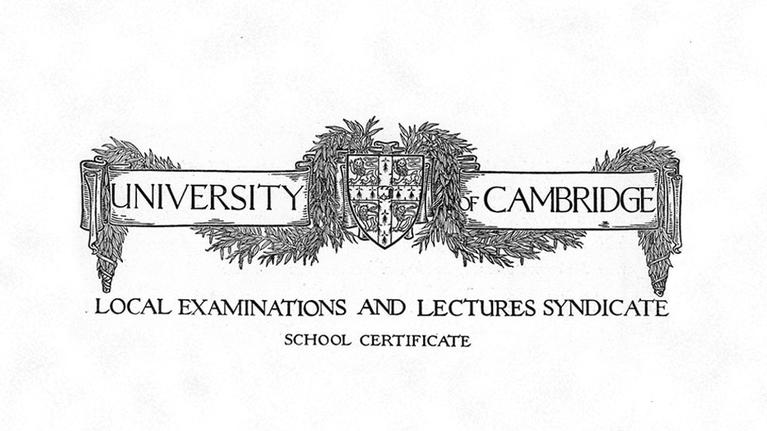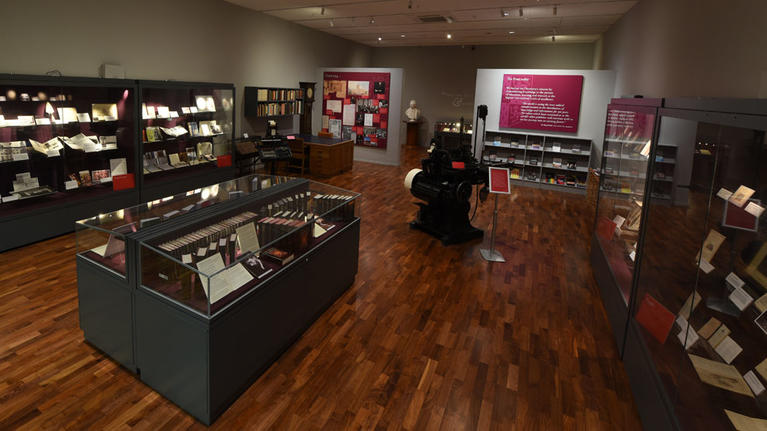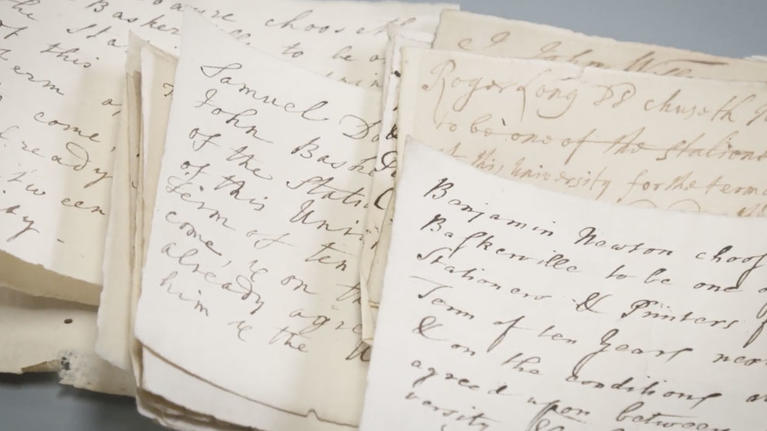Our Story - Timeline
History of Cambridge University Press & Assessment

1534
Letters Patent are granted to the University of Cambridge by King Henry VIII to print "all manner of books".
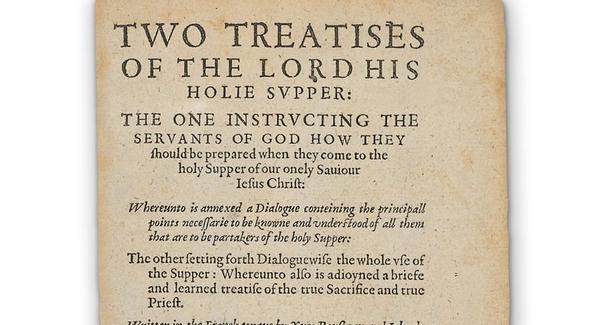
1584
The Press publishes its first book: Two Treatises of the Lord His Holie Supper.

1591
The first Cambridge Bible is printed by John Legate. It is an edition of the Geneva Bible, the popular Bible translation of the day. It is the Bible taken to America by the Pilgrim Fathers, and the version cited by William Shakespeare.

1629
The Cambridge folio edition of the King James Bible is printed by Thomas and John Buck. Considerable scholarly effort goes into producing an authoritative text, and many changes become standard in later editions.

1633
The Temple by George Herbert (1593 – 1633) is published containing his pattern poem ‘Easter Wings’ in which the words and lines are arranged on the page to create a visual image of the poem’s subject. The Temple is arguably one of the Press’s most typographically influential books in the 1630s and 1640s.

1638
Lycidas is published by John Milton (1608 –1674) as a tribute to Edward King, a fellow-student at Christ’s College and an aspiring poet, who drowned when his ship sank in 1637. The Cambridge University Library copy has corrections in Milton’s hand, including words omitted in the printing.

1713
The second edition of Isaac Newton's Philosophiæ Naturalis Principia Mathematica (Mathematical Principles of Natural Philosophy) is published by the Press. The Principia contains Newton’s laws of motion, which form the foundation of classical mechanics; it is one of the most important works in the history of science.

1763
John Baskerville produces the beautiful folio bible. His innovations with type, paper, ink, and the printing process itself, enable him to produce printed works of unparalleled elegance, crispness and clarity.

1799
Catharine Collignon is the first woman published by the Press with her four-volume translation from the French Dictionnaire Historique by Jean-Baptiste Ladvocat. It presents brief biographies of "emperors, kings, and great captains," gods and heroes, historians, poets, physicians, "learned women and painters".

1805
The Press pioneers the development of stereotype printing, producing the Cambridge Stereotype Bible. Stereotyping allows successive printings from one setting, improving the accuracy and stability of the text.

1833
The Pitt Building on Trumpington Street is completed. The architect, Edward Blore, designs a Gothic revival frontage to satisfy the University’s desire for grandeur with a less ornamental pressroom and warehouse out of sight on the north side of the court yard. It becomes the home of Press printing and publishing for more than a century.

1858
The University of Cambridge Local Examinations Syndicate (UCLES) is established, offering school leaving examinations in December, six months after the University of Oxford Delegacy of Local Examinations. 370 candidates sit exams at centres ‘local’ to their homes in Birmingham, Brighton, Bristol, Cambridge, Grantham, Liverpool, London and Norwich.

1864
The first international examinations are held for overseas candidates in Trinidad where six candidates take the Cambridge Senior Examinations. Centre boxes provide secure transport for examination scripts.

1865
Girls are allowed to enter the Cambridge Examinations on the same basis as boys. Four years later the Higher Local Examinations accept women intending to become teachers or enter to Newnham College Cambridge as shown here. From these exams emerges the Certificate of Proficiency in English.

1893
The Press journals publishing programme begins with the Journal of Physiology. The Journal of Hygiene and Biometrika follow swiftly, and by 1910 the Press has become a well-established journal publisher with a successful list which includes its first humanities title, Modern Language Review. 1956 sees the first issue of the Journal of Fluid Mechanics.

1895
The first title by a Nobel Laureate is published: J.J. Thomson’s Elements of the Mathematical Theory of Electricity and Magnetism. Later Nobel Laureates published by the Press include Ernest Rutherford (Chemistry), Elinor Ostrom (Economics), Subrahmanyan Chandrasekhar (Physics), Wole Soyinka (Literature), and William Nordhaus (Economic Sciences).

1910
The 11th Edition Encyclopaedia Britannica is published in 29 volumes. Sir Ernest Shackleton takes a set on board the Endurance and another set on the Aurora for entertainment and education during his Imperial Trans-Antarctic Expedition of 1914-1917.

1913
The Monotype system of hot-metal mechanised typesetting is introduced at the Press, leading to significant improvements in text quality and the layout of complex formulae. Text is entered via a keyboard, then a drum on the keyboard produces a perforated paper spool that is fed into a caster, which reads the tape and produces type ready for printing.

1913
The Certificate of Proficiency in English is introduced. The long examination attracts just three candidates in its first year but is joined in 1939 by a Lower (First) Certificate and, in 1946 by the Diploma in English Studies – completing the formation of the first suite of English language qualifications.

1941
The University of Cambridge Local Examinations Syndicate signs an historic agreement with the British Council to ensure the continuation of international and English examinations throughout the Second World War.

1949
The Press opens its first international branch in New York. North America had been an important market since the nineteenth century, with several agencies representing its interests. Macmillan had been the Press agent since 1920, and a Cambridge Department was created in 1929 until a small office is found for the new branch at 51 Madison Avenue.

1964
The West African Examinations Council is the first overseas Education Council to complete a localisation programme to run its own exams following the Cambridge model.

1985
Midland Examining Group (MEG) is set up to administer a new 16+ examination to candidates within its region. MEG administers the new national General Certificate of Secondary Education, launched in 1987. An International version, the IGCSE was launched by UCLES the following year. Progress House, shown at the opening here was a hub for UK school exams.

1990
The English Language Testing Service is re launched as the International English Language Testing Service (IELTS). IELTS develops rapidly and is available in 105 countries by 1993.

1992
The bookshop opened at 1 Trinity Street, Cambridge, extending the site’s history as a place where books have been sold continuously since at least 1581.

1998
Mergers with GCE and CSE boards was followed by a merger with the RSA Exams Board to create the UCLES Group and three distinct examination boards: Oxford, Cambridge and RSA Examinations (OCR), Cambridge International Examinations and Cambridge ESOL (English for Speakers of Other Languages). A new despatch warehouse serves the logistics of this expansion.

1999
Cambridge Dictionaries Online is launched. It's now the most visited dictionary for learners of English on the planet, with more than 500 million users in 2020.

2005
The University of Cambridge Local Examinations Syndicate adopts the name Cambridge Assessment as a reflection of a wider role in educational assessment.

2018
The Triangle Building on Shaftesbury Road is completed and Cambridge Assessment staff, comprising Cambridge Assessment English, Cambridge Assessment International Education and OCR, move into new accommodation next door to the Press.
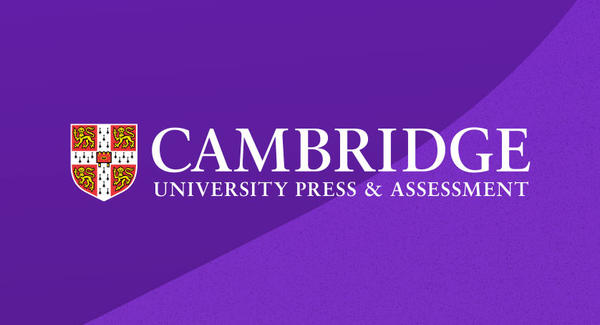
2021
Cambridge University Press and Cambridge Assessment come together to form Cambridge University Press & Assessment.


